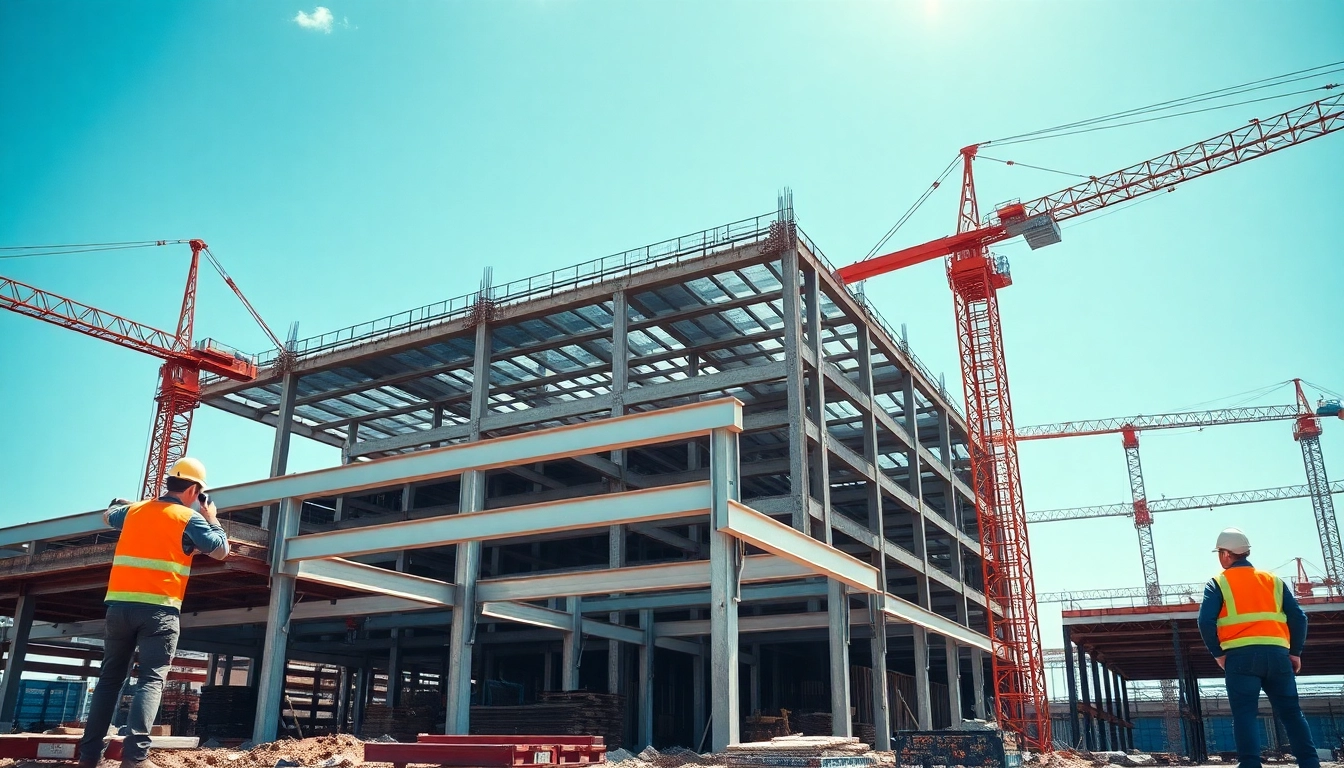Understanding Structural Steel Construction: Benefits, Techniques, and Applications
The Basics of Structural Steel Construction
Structural steel construction is a vital aspect of modern architecture and engineering, playing a critical role in the strength, safety, and durability of buildings and various structures. It is not merely a method of construction but a complex system involving a variety of steel shapes and components that come together to create robust frameworks. In this article, we will explore the fundamentals, advantages, key techniques, applications, and the future of structural steel construction. Let’s delve into the basic definitions and various aspects that form the backbone of contemporary construction practices.
What is Structural Steel?
Structural steel is a category of steel construction material that is made from refined carbon steel and is available in various grades and forms. These forms might include wide-flange beams, I-beams, channels, angles, and plates, designed to carry loads and withstand various conditions encountered in the construction environment. Structural steel’s fundamental property is its ability to bear large amounts of weight relative to its size, making it an exemplary choice for supporting structures ranging from skyscrapers to bridges.
Types of Structural Steel Used in Construction
There are several types of structural steel commonly used in construction, each possessing unique properties that make it suitable for specific applications:
- Carbon Steel: The most commonly used type, characterized by its strength and versatility, which varies depending on the carbon content.
- Alloy Steel: This form includes various elements, such as chromium, nickel, or molybdenum, to enhance properties like durability and resistance to wear.
- Stainless Steel: Known for its resistance to corrosion, stainless steel is vital for structures exposed to harsh environments.
- High-Strength Low-Alloy Steel (HSLA): This steel provides better mechanical properties than carbon steel and is typically used in structural applications.
- Fatigue-Resistant Steel: Specifically engineered to withstand cyclic loading, this type is ideal for structures like bridges, which experience repetitive stress.
The Role of Structural Steel in Modern Architecture
Structural steel’s role extends beyond mere functionality; it also influences the aesthetic and architectural aspects of a building. With its versatility, it allows for innovative designs and can accommodate large spans without the need for extensive support. As a result, architects often exploit structural steel’s characteristics to create open spaces, large windows, and distinctive shapes, which contribute to the overall beauty of firms’ projects.
Advantages of Structural Steel Construction
The popularity of structural steel in construction is grounded in various compelling advantages, which can significantly affect project timelines, costs, and overall quality.
Economic Benefits and Cost-Effectiveness
One of the most substantial advantages of structural steel construction is its economic efficiency. Prefabrication allows components to be mass-produced in a controlled environment, minimizing waste and errors. This process results in quicker assembly on-site, thus reducing labor costs and overall construction time. Moreover, its high strength-to-weight ratio means less material is required, further cutting expenses.
Strength and Durability of Structural Steel
Structural steel’s inherent strength provides excellent load-bearing capability, withstanding substantial weight and environmental forces such as wind and earthquakes. Its durability ensures that buildings maintain structural integrity through varying temperature changes and moisture exposure. Structural steel also has a lower maintenance cost compared to other materials, as it does not rot or decay like wood.
Sustainability Factors in Steel Construction
The construction industry is increasingly focusing on sustainability, and structural steel construction is recognized for its environmentally friendly qualities. Steel is 100% recyclable without losing its properties, helping to minimize the carbon footprint of construction projects. Additionally, the efficient use of materials contributes to less landfill waste, while robust structures result in lower energy consumption throughout their lifecycle.
Key Techniques in Structural Steel Construction
To maximize the benefits of structural steel, specific construction techniques and practices are employed that ensure efficiency, safety, and reliability throughout the construction process.
Typical Construction Processes
The process of constructing a building with structural steel generally involves several key stages:
- Design: Engineers develop detailed architectural and structural plans to outline specifications, dimensions, and necessary components.
- Fabrication: Steel components are manufactured off-site, where they are cut, welded, and pre-assembled, which speeds up the construction timeline.
- Transportation: Fabricated pieces are transported to the construction site for assembly.
- Assembly: On-site workers lift and position the steel components into place, typically utilizing cranes for the installation.
- Inspection and Quality Control: The structure undergoes thorough inspection to verify that all connections and components meet safety and engineering standards.
Advanced Fabrication Methods for Steel Components
Today, advanced technology has revolutionized steel fabrication. Computer numerical control (CNC) machines allow for high-precision cutting and shaping of steel components, resulting in enhanced accuracy and efficiency. Robotics is also being integrated into the assembly process, further streamlining operations and minimizing human error. Off-site fabrication techniques, such as modular construction, enable different parts of a structure to be produced simultaneously and assembled much faster on-site.
Safety Practices and Regulations
Construction projects involving structural steel demand stringent adherence to safety protocols and regulations. Compliance with Occupational Safety and Health Administration (OSHA) guidelines is mandatory to protect workers from hazards associated with heavy lifting, working at heights, and the operation of machinery. Implementing comprehensive safety training, regular equipment inspections, and emergency preparedness plans can significantly mitigate risks on construction sites.
Applications of Structural Steel in Various Industries
Structural steel is a versatile material that finds extensive applications across various industries, facilitating the construction of numerous structures.
Commercial Building Projects
In commercial construction, structural steel is widely used for office buildings, shopping centers, and high-rises due to its ability to support open floor plans and expansive spaces. This flexibility makes it ideal for businesses looking to maximize usable area while maintaining design aesthetics.
Industrial Structures and Warehouses
Structural steel’s strength and durability make it a top choice for industrial buildings and warehouses, which often require large open spaces for machinery and inventory storage. The quick assembly and longevity of steel structures allow businesses to scale up operations efficiently.
Infrastructure Development: Bridges and More
In infrastructure projects, structural steel plays a critical role in building bridges, overpasses, and other transportation systems. Its high strength-to-weight ratio and ability to withstand environmental forces make it an essential element in creating safe and functional infrastructure that endures the test of time.
The Future of Structural Steel Construction
As construction practices evolve, the future of structural steel construction appears promising, driven by innovative technologies and shifting industry paradigms.
Innovative Trends in Steel Design
Some of the innovations emerging in structural steel design include the use of advanced materials, like ultra-high-performance concrete (UHPC), synergistically with steel to create lighter yet stronger structures. With structures becoming more complex, parametric design and computational analysis tools allow architects and engineers to model various structural forms for optimal efficiency and performance.
Impact of Technology on Steel Construction
Technological advancements such as building information modeling (BIM) are reshaping how construction teams collaborate. BIM allows for real-time updates, enhances visual understanding, and improves coordination among all stakeholders. This level of technology adoption helps prevent issues before they arise and promotes efficient project management.
Challenges and Opportunities Ahead
While structural steel construction offers myriad benefits, it does come with challenges such as fluctuating material prices and labor shortages. However, these challenges present opportunities for innovation, prompting the industry to explore new material sources, enhance training programs, and adopt efficient construction methodologies to overcome these hurdles.
In conclusion, structural steel construction is a cornerstone of modern architecture, offering durability, versatility, and sustainability that shape the skylines and infrastructure of our world. As technological advances continue to evolve, so will the ways in which we utilize and implement structural steel in construction. By understanding its principles and applications, stakeholders can harness the full potential of this essential material.



